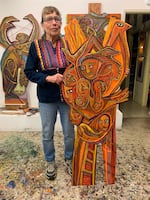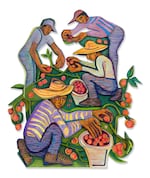Ashland’s Betty LaDuke is one of Oregon’s most internationally recognized artists. She has been traveling the world for more than 60 years, sketching and painting, telling the stories of people linked to land and community. Her colorful, evocative paintings are rooted in “survival rhythms, rites of passage and the expression of joy and sorrow.”
LaDuke graduated from New York’s High School of Music and Art and went on to study in Denver and Cleveland before starting a two-year scholarship at the Instituto Allende in San Miguel de Allende, Mexico. Those years had a lasting impact, forging her vision for creating art that explores world culture.

Betty LaDuke with "Almeda Fire, Agony and Resilience," in her Ashland studio.
Eric Slade
In 1964, she began teaching art at Southern Oregon University, working there for 32 years. But she took frequent breaks and sabbaticals to travel to Africa, Latin America and Southeast Asia, where she immersed herself in the art of the community, making sketches that sparked her colorful paintings back home.
In 2010, LaDuke began creating “Oregon Harvest,” a series of paintings celebrating Southern Oregon agricultural workers. Pieces from the series are now on display in the Oregon State Capital. LaDuke’s work has shown at galleries and museums around the world. The Portland Art Museum has nearly 200 works by LaDuke in their permanent collection. At age 87, she continues her artistic practice at her studio in Ashland.
Oregon Art Beat’s Eric Slade talked with LaDuke about her lifetime of creating art.
Slade: What do you love about painting?
LaDuke: I enjoy the process of painting because it just is part of me in the sense that it’s both mental and physical. I like the sense of movement. I like the sense of thinking about what I’m doing, but also sometimes just reacting angrily, happily, all kinds of moods, it catches it all. Sometimes I’m really confident. I know what I’m doing, and it just moves, and sometimes I’m frustrated and just have to work it through.
I love having my studio be part of my home because I can walk in and out. Even if I’m cooking in the kitchen, I can come and look and think about what I’ve done, and it registers so that I’m working even when I’m not holding the paintbrush in my hand.
Slade: Can you talk about why you moved from painting on canvas to painting on cut out wooden panels?
LaDuke: I don’t like being confined to rectangles, to squares — too rigid, you know? So what I like about the panels is … I can recreate the form so it holds an energy of the image. I want to portray it in the image. It doesn’t have extra stuff. It is the essence. And I kind of like that.
But also what gives birth to the panels is the original sheet of plywood that they come from — the texture, the knots, and the energy of the tree that is in the plywood. So the panels have life already when I start to use them. And then it’s working with the life that they themselves offer me, to give it the story that I want them to hold.
Slade: Tell me about the summer camp you attended when you were growing up in the Bronx.
LaDuke: Because I was an only child, my parents could afford to send me to a summer camp. It was called Workers Children’s Camp. The fee was very modest and it was a camp that had kids from all over the city. Kids of different ethnic backgrounds and different neighborhoods and communities and so on. It was a great melting pot, which was wonderful. And the counselors were also of different backgrounds … including people like Pete Seeger many, many times. And I was honored, as I think back, to meet Paul Robeson. I think I was aged 9 and he came and visited the camp, and he held my hand for a moment. You don’t forget that.
Slade: Do you think of yourself as an activist?
LaDuke: I think it’s a label that’s been given to me … but I think I do. I don’t have a dogma that I follow issues of the here and now. I’m aware of a great deal of suffering and a great deal of joy. I pick up on certain issues. I tend to care about people who are linked to communities to land. I also now have been doing the exact opposite. I tend to work with anger and frustration and annoyance at places and people I’m not necessarily so very close to, but have a sense of what they’re going through and have an empathy. I want to offer a voice of saying, “I see you and I hear you and I want to present what I can about what I feel about you.”

Betty LaDuke, "Oregon Cherry Tomato Harvest," 2010
Rob Jaffe
Slade: Looking back on your body of work, how do you feel?
LaDuke: One of the great pleasures is beginning to take the time to look. Because sometimes you don’t take the time. It’s just keep working, working, working. And I’m beginning to feel honored that people are beginning to say, “Hey, this is nice — this a good legacy here that’s with us and it will be with us.” That makes me feel good. And to see the many seasons of the work — there isn’t any one thing, it isn’t any one style. It is its own persona, its own being.
Betty LaDuke has new work on view now at Hanson Howard Gallery in Ashland. Proceeds from the sale of prints of LaDuke’s print Awakening will be donated to organizations assisting Rogue Valley farm workers who lost their homes to the Almeda Fire.


